SAFFRONART SETS RECORD FOR INDIAN ARTIST
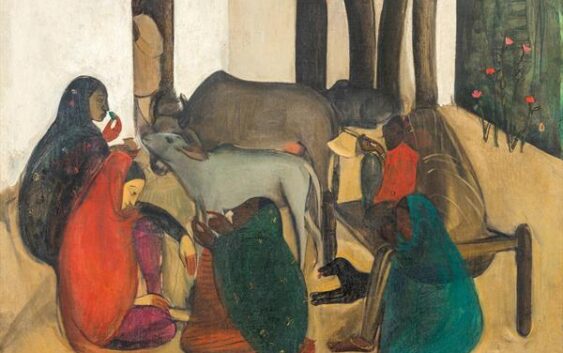
At the Saffronart auction house’s Evening Sale: Modern Art, Sept 2023, Indian artist Amrita Sher-Gil’s painting, The Story Teller and dated 1937 fetched a crazy $7.45 million at the auction in New Delhi, to become the most expensive piece of Indian art sold under the hammer. Sher-Gil is widely regarded as one of the most influential contemporary female artists due to the quality of her work.
The iconic work led Saffronart’s ‘Evening Sale: Modern Art’, which featured over 70 artworks from several artists, included modern masters VS Gaitonde and Raza, and early works by Tyeb Mehta, M F Husain, F N Souza and Akbar Padamsee. The SaffronArt auction was held at the luxurious Oberoi hotel, New Delhi, where the artwork was sold, generated over Rs 181 crore in all.
Sher-Gil herself named this painting as one of her 12 most important works, and it’s widely regarded as one of her most honest and emotional pieces. The story teller was first exhibited in Lahore in 1937 during her well-known solo show at Faletti’s Hotel.
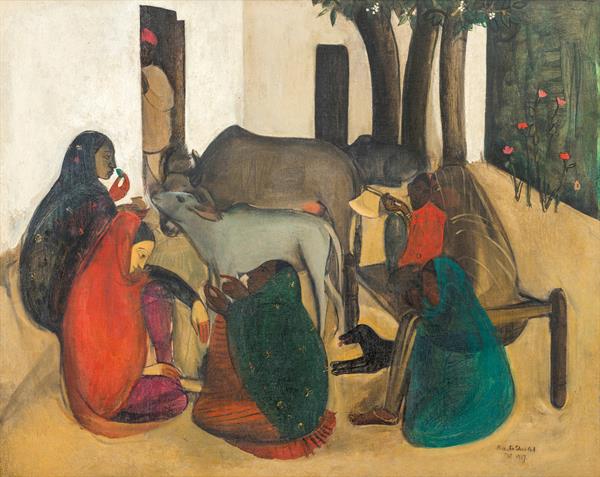
AMRITA SHER-GIL (1913 – 1941)
The Story Teller
Signed and dated ‘Amrita Sher-Gil/ Oct.
1937′ (lower right)
1937
Oil on canvas
23.25 x 29.25 in (59 x 74 cm)
Winning bid
Rs 61,80,00,000 | $7,445,783
It’s a portrait of a woman in her home, surrounded by five other women, all of whom are doing their daily chores with the help of a herd of cows. It has the classic Sher-Gil style of art that focuses on the feudal-femininity of women. Sher-Gil’s other famous portraits of women include: “Three Girls,” “Women on the Charpai,” “Hill Women,” and “Young Girls.”
The most expensive piece of Indian art ever sold at an auction in the world, Amrita Shir-gil’s oil on canvas “The Story Tiller”, has been purchased for an impressive sum of Rs 61.8 crore. This surpasses the previous record of Rs 51.75 crore set by Sayed Haidar Raza’s 1989 oil on canvas painting, “Gestation”, few weeks back
Indian artist Subodh Gupta “The Story Teller is one of Amrita Sher-Gil’s most significant works. It portrays women, a common theme in her art, reflecting her indomitable spirit and dedication to her craft which has left an indelible mark on Indian art history. This makes her a cherished national treasure, a symbol of empowerment and someone whose work ushered in profound social change.”
Sher-Gil’s renowned composition, “The Story Teller”, is widely regarded as one of her most honest and expressive works, and is one of the 12 works she personally identified as her most significant.
Sher-Gil’s previous record-holder was a painting called “The Ladies’ Enclosure,” which sold for $4.95 million in July 2021 (including the premium). She’s also known as “Frida Kahlo,” or “the Indian Frida,” and is considered one of the most influential 20th century female artists. She combined architecture with people to create scenes of rural life through her unique artistic language.
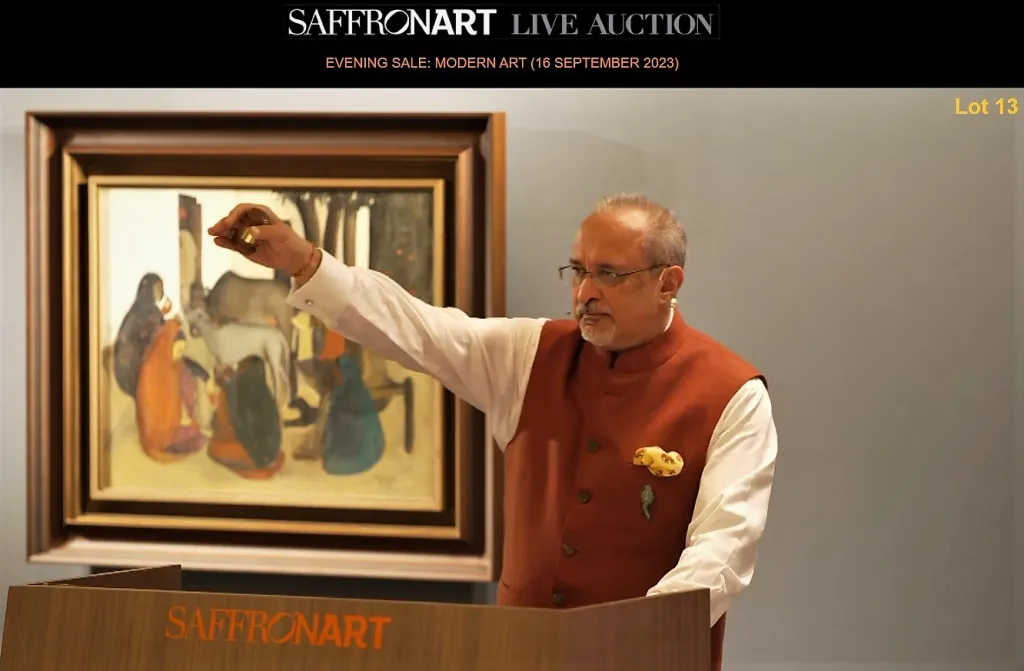
“We are delighted to have set multiple artist records at our Evening Sale in New Delhi this September. Most significantly, the record price achieved by Amrita Sher-Gil’s The Story Teller is an important milestone in the Indian art market and a testament to the artist’s immense skill and enduring legacy as one of India’s art treasures,” said Dinesh Vazirani, chief executive of Saffronart.
“The sale of this particular work is an important milestone in the market. However, equally important, is the work itself—it is an exceptional painting as a cornerstone in Sher-Gil’s work as such. She is one of India’s national art treasures, and this type of work is quite rare to come across for sale,” said Minal Vazirani, the auction house’s co-founder.
Few highlights from the auction –
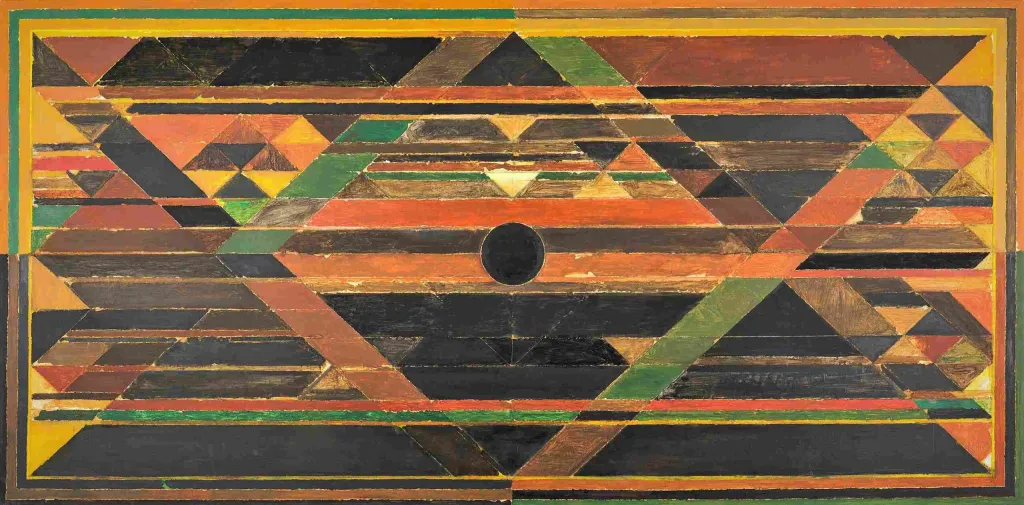
S H RAZA (1922 – 2016)
Earth
Signed and dated ‘RAZA ’86’ (lower right);
signed, dated and inscribed ‘RAZA/…
1986
Acrylic on canvas
39.5 x 78.5 in (100.3 x 199.4 cm)
Winning bid
Rs 4,44,00,000 | $534,940
“The geometry is established but the actual relation to colour with another colour is a question of harmony. Colours can reveal innumerable human sentiments that we are capable of and I am trying to make them live on the canvas.” – S H RAZA
Raza’s identification with India is particularly evident during this period, when he produced works that were rooted in the natural world as well as in Indian philosophical, religious and metaphysical ideas. S H Raza’s exhortations are imbued with a profound sense of belief, delicately conveyed through the use of form and color symbolism. He is remembered as a “believer to the core”.
“What he has been painting is not only interrelated shapes painted with dexterity and with great awareness of the potency of colours, but paintings evocative of certain states of being. The formal shapes in their selected colours are inextricably bound with the states which they create… His achievements, the acme of devotion and persistence, are a matter of pride for all of us.” (Khanna, p. 19)
“This is a great testimony to the growing importance of the Indian contemporary art scene. We are seeing a lot of investments coming in from people who believe that art is an asset class, especially in the case of Indian masters, which appreciate in value. The new record heralds interest in India’s national treasures. The auction house has built a wide network of aficionados who seem too happy to be part of the record-setting scenario,” Raza’s collectors have come from the world over, including strong interest from Europe, said Independent art critic and curator Uma Nair.
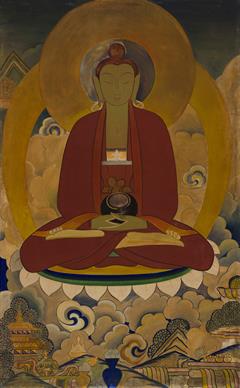
JAMINI ROY (1887 – 1972)
Untitled
Tempera on canvas
50 x 31 in (127 x 78.7 cm)
Estimate
Rs 40,00,000 – 60,00,000
$48,195 – 72,290
NON-EXPORTABLE NATIONAL ART TREASURE
Artwork Details
Winning bid
Rs 1,68,00,000 | $202,410
Untitled
“A picture is what it is: Man creates it. And whatever man creates reflects his character, daily life, his innermost thoughts, indeed everything.” — JAMINI ROY
Jamini Roy’s ambition to express himself through art was the driving force behind his career and successful experiments, inspired by a deep-seated enthusiasm for the pursuit of self-expression. His academic background and commitment to form and design enabled him to create a visual language enhanced by characteristic sweep lines and vibrant hues. His contributions to Indian art are appreciated for their modernist interpretation of folk art, which emphasized the importance of simplicity and form to ensure its accessibility to a wide range of audiences.
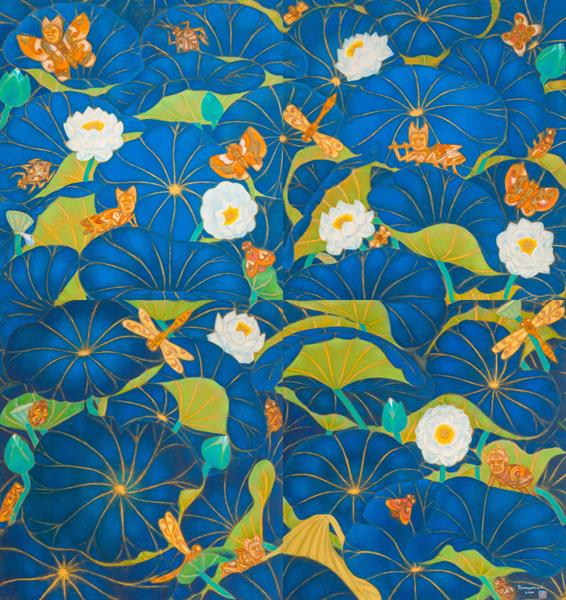
A RAMACHANDRAN (b.1935)
Autobiography of an Insect in the Lotus
Signed and dated ‘RAMACHANDRAN/ 2000’ and
bearing artist’s stamp (lower…
2000
Oil on canvas
112.25 x 106 in (285 x 269 cm)
Estimate
Rs 85,00,000 – 1,20,00,000
$102,410 – 144,580
Winning bid
Rs 4,44,00,000 | $534,940
Artwork Details
Autobiography of an Insect in the Lotus Pond
“As a boy in Attingal, I loved diving into the warm waters of the lotus pond…” – A RAMACHANDRAN
“The growing presence and importance of nature in Ramachandran’s post-Yayati oeuvre [mural, 1984-86] is particularly noteworthy because nature is conspicuously absent from his early work.” (R Siva Kumar, A Ramachandran: A Retrospective, Volume 2, New Delhi: Vadehra Art Gallery, 2003, p. 140)
The artist’s interest in lotus ponds began during his annual visits to Rajasthan in the 1970s, particularly in the vicinity of Udaipur. In 1985, the artist created ceramic works that were some of the first depictions of lotus ponds in his work. This subject gradually became a deep and significant focus of his artistic development.

